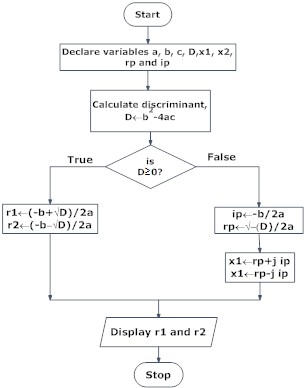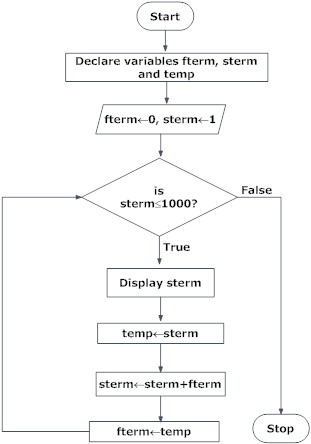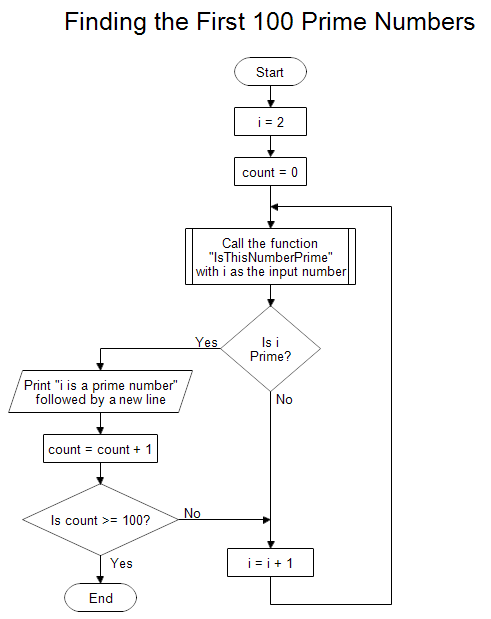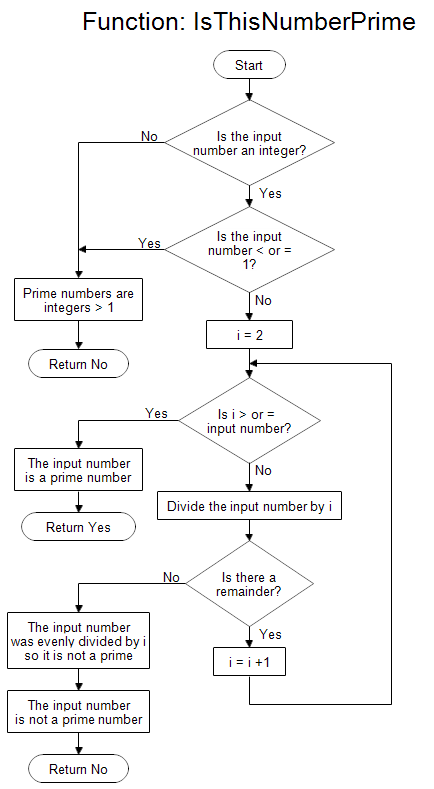books for flow chats
click here
Flowchart In Programming
Flowchart is a diagrammatic representation of an algorithm. Flowchart are very helpful in writing program and explaining program to others.Symbols Used In Flowchart
Different symbols are used for different states in flowchart, For example: Input/Output and decision making has different symbols. The table below describes all the symbols that are used in making flowchart| Symbol | Purpose | Description |
|---|---|---|
| Flow line | Used to indicate the flow of logic by connecting symbols. | |
| Terminal(Stop/Start) | Used to represent start and end of flowchart. | |
| Input/Output | Used for input and output operation. | |
| Processing | Used for airthmetic operations and data-manipulations. | |
| Desicion | Used to represent the operation in which there are two alternatives, true and false. | |
| On-page Connector | Used to join different flowline | |
| Off-page Connector | Used to connect flowchart portion on different page. | |
| Predefined Process/Function | Used to represent a group of statements performing one processing task. |
Examples of flowcharts in programming
Draw a flowchart to add two numbers entered by user.



Q Finding Prime Numbers Flow Chart - RFFlow
| Description | Prime numbers are positive integers that can only be divided evenly by 1 or
themselves. By definition, negative integers, 0, and 1 are not considered prime
numbers. The list of the first few prime numbers looks like: 2, 3, 5, 7, 11, 13, 17, 19, 23, 29, 31, ... For example, 5 is a prime number because you can divide 5 by 1 evenly and divide 5 by 5 without a remainder, but if you divide 5 by any other integer, you get a remainder. 5/1 = 5 5/2 = 2 plus a remainder 5/3 = 1 plus a remainder 5/4 = 1 plus a remainder 5/5 = 1 5/6 = 0 plus a remainder ... = 0 plus a remainder Now look at the number 4 which is not a prime. 4/1 = 4 4/2 = 2 4/3 = 1 plus a remainder 4/4 = 1 4/5 = 0 plus a remainder ... = 0 plus a remainder The number 4 can be divided by 2 evenly, so it is not a prime. The flowchart shown above describes a function that is given a number i and returns whether it is prime or not. The name of the function is "IsThisNumberPrime." First it checks to make sure the input number is an integer. Then it checks to make sure the input number is not negative, 0 , or 1. Negative integers, 0, and 1 are not considered prime by definition. Next the function tries to divide the input number by i, where i = 2, 3, 4, 5, and so forth, to see if it divides any of them evenly, that is, without a remainder. If the input number is divided evenly, it is not a prime. The check stops when i is equal to the input number. You give the function a number and the output is "Yes" if the number is prime, or "No" if it is not. Now suppose you want to calculate the first 100 prime numbers. A flowchart to show that process is shown below.  The flowchart above starts with the number 2 and checks each number 3, 4, 5, and so forth. Each time it finds a prime it prints the number and increments a counter. When the counter hits 100, it stops the process. To determine whether a number is prime, it calls the function "IsThisNumberPrime" which is shown at the top of this page. The first few primes are quickly calculated, but as the primes get further apart the computation time increases. Finding large primes is a task for super computers. |
| Drawing Instructions | If you haven't already done so, first download the
free trial version of RFFlow. It will allow you to open any chart and make
modifications. Once RFFlow is installed, you can open the above charts in RFFlow. Click on prime-numbers.flo for the top flow chart or finding-prime-numbers.flo for the bottom flow chart. From there you can zoom in, edit, and print these sample charts. It is often easier to modify an existing chart than to draw it from scratch. To draw this flow chart without downloading it, run RFFlow, click on the More Shapes button  ,
scroll and open the Flowcharting folder, click the Physical
Flowcharting stencil and click the Add Stencil button. ,
scroll and open the Flowcharting folder, click the Physical
Flowcharting stencil and click the Add Stencil button.
|
if else statement and flowchart
Decision Control Statements and Flowchart
The if Statement
It is used to execute an instruction or sequence/block of instruction only if a condition is fulfilled.
Difference forms of implements if-statement are:
- Simple if statement
- if-else statement
- Nested if-else statement
- else if statement
 |
| Figure: Simple if statement syntax and flowchart |
 |
| Figure: if-else statement syntax and flowchart |
Nested if-else statement
In nested if...else statement, an entire if...else construct is written within either the body of the if statement or the body of an else statement.
The syntax is as follows:
if(condition_1)
{
if(condition_2)
{
block statement_1;
}
else
{
block statement_2;
}
}
else
{
block statement_3;
}
block statement_4;
 |
| Figure: nested if-else statement flowchart |
Else if statement
It
is used in multi-way decision on several conditions. This works by
cascading comparisons. As soon as one of the conditions is true, the
statement or block of statements following them is executed and no
further comparison are performed.
The else...if syntax is as follows:
if(condition_1)
block statement_1;
else if(condition_2)
block statement_2;
else if(condition_n)
block statement_n;
else
default statement;
 | ||||||||||||||||||||||||||||||||||||||||||||||||||||||||||||||||||||||
| Figure: flowchart for else...if statement |
Flowchart for finding Armstrong number
Ans.
for Armstrong number C program source code click below link:
Finding Armstrong number C program
Flowchart for finding Armstrong number C program:
 |
| Figure: Flowchart for finding number is Armstrong or not C program |
Factorial C program,Algorithm,Flowchart
Ans.
/*c program to find out factorial value of a number*/
#include<stdio.h>
#include<conio.h>
int main()
{
int n,i,fact=1;
printf("Enter any number : ");
scanf("%d", &n);
for(i=1; i<=n; i++)
fact = fact * i;
printf("Factorial value of %d = %d",n,fact);
return 0;
}
The output of above program would be:
Algorithm for calculate factorial value of a number:
[algorithm to calculate the factorial of a number]
step 1. Start
step 2. Read the number n
step 3. [Initialize]
i=1, fact=1
step 4. Repeat step 4 through 6 until i=n
step 5. fact=fact*i
step 6. i=i+1
step 7. Print fact
step 8. Stop
[process finish of calculate the factorial value of a number]
Flowchart for calculate factorial value of a number:
 |
| Figure: Flowchart for calculate factorial value of a number C program |
 Figure: Flowchart for check given number is
Figure: Flowchart for check given number is prime number or not

Bravo i must say this is Brilliant!!!!
ReplyDeleteNice flowchart diagrams. What is the flowchart software you used to create these flowchart diagrams ? Is it creately?
ReplyDeleteA company’s salesmen are selling toothpaste and tooth powder. The company having 50 salesmen gives 10% commission on the sale of toothpaste and 20% commission on tooth powder. Draw a flowchart to compute and print the total sale and the total commission for each salesman.
ReplyDeletewow fantastic
ReplyDeleteথেংক you for be answer
DeleteThanks for the explanation and examples,but I wonder if the middle print command in the second example of deciding the biggest of three numbers should be C not B. and the left one should be B not C; in other words, they should be switched.
ReplyDeleteyou might be right. I encountered the problem. Good job though.
DeleteI love you
DeleteSorry my চিষ্টেম write আৰু thank you for be answer
DeleteIn "Flowchart for prime number "
ReplyDeleteFLAG=1 and its never equal to 0... Then further step is not going to execute...[steps when the value is true] only the value for false condition is going to run which gives "Print number is prime" all the time......
Does FLAG have special meaning????
Also to mention, rest of the flowcharts helped me a lot and I am thankful for that..... Next thing I have to say is:: "books for flow chats
ReplyDeleteclick here" at the top.... There is spelling error. Good for you if your corrected that...Thanks indeed...
Whoa!!! Aren't these your own contents????? You have just copied others content......
ReplyDeleteI found the same thing on the website:
http://www.rff.com/prime-numbers.htm
Is this your website....??? I don't think so...
the largest among 3 numbers has a little correction i think.
ReplyDeleteYour Questions find prime numbers flow chart very long.
ReplyDeleteI solve it very sort
How....?
DeleteNice
ReplyDeleteclear explanation.......nice
ReplyDeleteThe flowchart which is used to find the largest of three numbers contain an error in it so kindly rectify that as soon as possible.thank you
ReplyDeleteSuper site
ReplyDeleteSend mi. How can write algorithum & flowchart for user define function orrecursion
ReplyDeleteone of the indian bank that also give loans is facing problem of doing data entry manually of loan application & then checking manually if the application is eligible for loans .Hence it has requested you to develop a software stystem which can
ReplyDeleteThe data entry operators directly input the data into the software.There are certain fields that are considerd to be mandatory, hence if data is not enterd in those fields the application is rejected
Once the data is updated into the database then automatically do a credit risk check(referred to as credit rules) of whether the application is eligible for loanor not
in case yes, then what should be the amount uoto which the loan can be given?
Then finally compute the loan approved amount(LAA) that would be the lower of the two i.e the loan eligibility amount(LEA) or the loan requested amount(LRA)
note that the system needs to be designed in such a way that credit ruels can be easily added or modified or new rules introdused & some old rules removed
Not that for different kinds of loans (i.e housing loans,vehicle loans) there would be different set of credit rules.Also for different Loans types, Some fields shall be mandatory for loan types & some fields only specific to that loan Type
You are required to develop:
A) Business Flow(Flow Chart)
ASSUMPTIONS:
Field included in a loan application from:
1. Name
2.City
3.Age
4.Vehicle Details(mandatory for vehicle loan)
5.House details(mandatory for house loan)
6. Occupation Types(OT) status:
a)N=Not working b)E=Employed c)B=Business(the data entry operator shall get a Drop Down for this field in the software screen & shall select one of the three values from above. In the system ,the are coded as N or E or B
7.Loan Request Amount(LRA)
8.Annual income as per income tax return
9.Previous loan outstanding- ?Yes or No
10.Previous loan amount(PLA) (if the above is true this field shall get active & becomes a mandatory for input)
11.Passport no.(Compulsory):
Bank's criteria or Rules to approve loans and the amounts thereof are
1.Gives loan to person of age between 18 to 60 years
2.if person is running a business then ,eligibility is 20% lower than the loan eligible amount that would be computed from the below tabel
3.this table gives a decision table to show the income range of the applicant & the way to compute the loan eligible amount
Annual income range | loan eligible Amount
0-2lacs | not eligible amount
2-5lacs | 50% of the avg.annual salary
5-10lacs | 80% of the avg.annual salary
10lacs&above | 75% of the avg.annual salary
4.Maximum LAA can notexceed 1 crore
Very informative blog!
ReplyDeletePlease take some time to visit my blog @
Flowchart in Computer programming
Thanks!
it was useful to me for my mid examination .thank you so mutch.keep up the good work.god bless you
ReplyDeleteHow to write a flowchart by storing numbers in an array and print
ReplyDeleteThem
You are doing great job for students
ReplyDeleteDraw a flow chart for the computer program that takes number A and B and divide them as (answer= A/B). 3 should always be greater than 0 a program should print "invalid number" if the inserted number is less than or equal to zero and faros the user to retype the number
ReplyDeleteInput a number and draw a flow chart to print mathematical table of the number (use
ReplyDeleteloop).
Eg: 5x1 = 5
5 x 2 = 10
5x3 = 15
5 x 10 = 50
Urgent needs the answer
Thanks buddy it was useful for me
ReplyDeleteCreate a flow chart that will identify if the user input number is a zero or real nonzero number, Then translate it into java codes
ReplyDeleteNOTE : A real nonzero number must be either positive or negative numbers
Develop a flowchart to calculate the tuition fee for a student at an University. The program should prompt for and accept the idnumber and the total number of credits for which he/she has enrolled. The bill outputted should contain the idnumber and tuition fee.
ReplyDeleteCalculate the tuition fee as follows:
Total credits of 15 or more indicates that the student is full-time. Full-time students pay a flat rate of $35,000 for tuition.
Total credits of less than 15 indicate that the student is part-time. Part-time students pay $850 per credit for tuition.
After printing the tuition fee, ask the user if s/he wants to calculate the tuition fee for another student – “Y” for yes and “N” for no. (This question is asked each time the tuition fee is printed). If s/he does, allow him/her to enter another student’s idnumber and total number of credits and find the tuition fee again. If the answer is no, the flowchart must be terminated with an appropriate message.
good
ReplyDelete